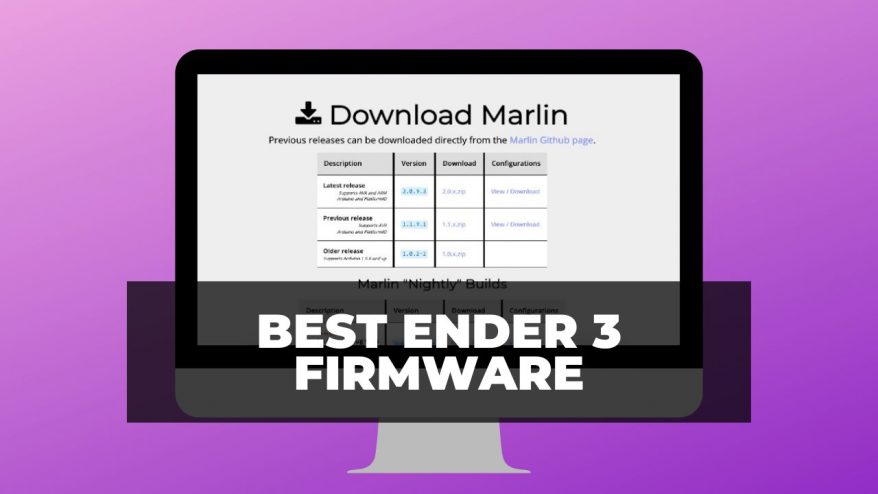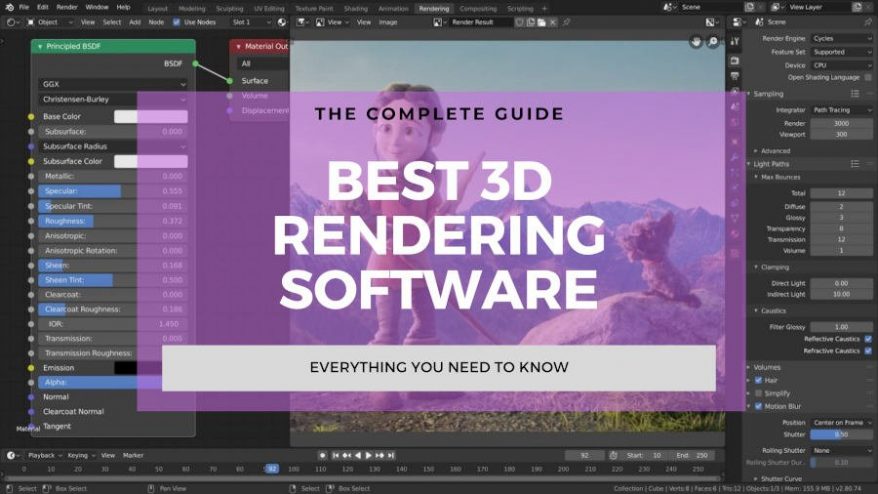
6 Best 3D Rendering Software 2023 (Some are Free!)


At 3DSourced we’ve covered everything 3D printing and 3D since 2017. Our team has interviewed the most innovative 3D printing experts, tested and reviewed more than 20 of the most popular 3D printers and 3D scanners to give our honest recommendations, and written more than 500 3D printing guides over the last 5 years.
The best 3D rendering software is a crucial tool for professionals across a huge range of industries – architecture, film and VFX, video games, automotive design, fashion – the list goes on. It allows users to take user-created 3D models and bring them to life in fully-realized 3D environments or images.
- We also have a ranking of the best free 3D modeling software.
There’s a wide variety of 3D rendering software solutions available, each being unique in their own way. So when it comes to choosing a 3D rendering software to use, you need to take a range of factors into consideration to make sure you pick the best one for you.
Are you looking for software that offers CPU rendering, GPU rendering or both? What rendering features do you need? What material types do you need? What 3D modeling and CAD programs is the rendering software compatible with? These are just a few of the considerations you’ll need to make.
Of course, you’ll also need to think about price. High-end commercial 3D rendering software can cost thousands of dollars, so it’s not accessible to everyone. Luckily, there are several high quality open-source software options that are completely free to use.
In this guide, we reveal the best 3D rendering software available right now, covering both free and commercial solutions. We’ll take a look at the key aspects of each program to help you find the best 3D software for you. Before that, though, let’s take a closer look at exactly how 3D rendering software works.
Best 3D Rendering Software – Full Round-Up
Best Free 3D Rendering Software
- Blender: Overall Best Free 3D Rendering Software
- LuxCoreRender: High Quality, Physically-based Rendering Software
Best Paid 3D Rendering Software
What is 3D Rendering Software?
3D rendering is the final step in the 3D animation process. It essentially involves the transformation of 3D models that can only be viewed in special software into fully realized images and videos can be viewed by anyone, for example, in the form of a movie on our TV, laptop or smartphone.
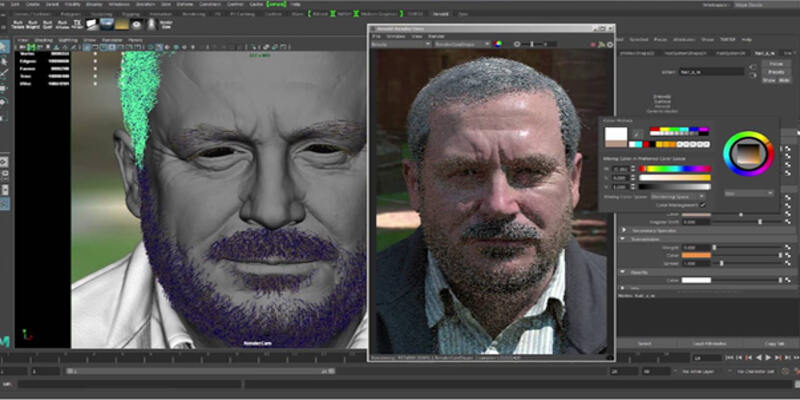
3D rendering is used in conjunction with 3D modeling and CAD software. Once the models are complete, designers and developers insert objects and characters into graphically appropriate settings.
The best 3D model rendering software allows users to add effects like lighting, texturing and weather to bring environments to life, and 3D rendered images are usually interactive, navigable and scalable.
3D Rendering Applications
3D rendering is used across a wide variety of industries. The most recognizable use is in the entertainment industry, specifically in movies and video games. These days, virtually every film or video game that uses CGI or animation has used 3D rendering software in the production process.
Another industry which makes major use of 3D rendering software is architecture. Some rendering software, such as Lumion, are specifically made for architects. While architects use CAD software to come up with initial designs, models and blueprints, 3D rendering software allows them to bring these designs to life in a format that’s easily shareable and understandable.
- We also have a ranking of the best architecture software.
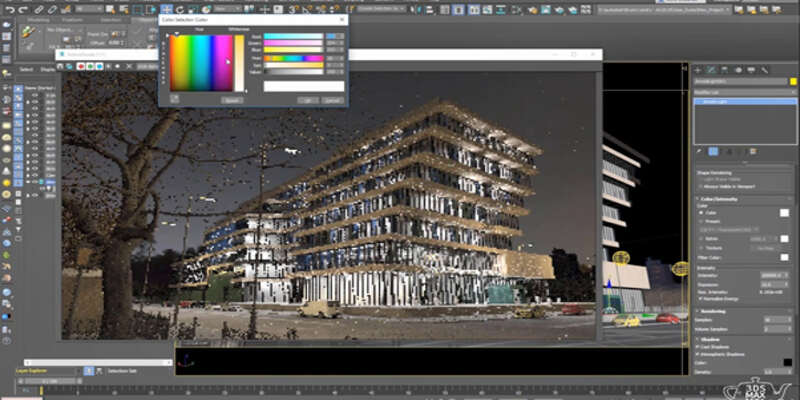
Another interesting use of 3D rendering software is in the healthcare industry. It can be used in the process of creating fully realized, 3D images of prosthetics, scanned body parts, tools, and implants that are easily accessible by different healthcare workers, potentially helping to increase the accuracy and efficiency of procedures.
Other industries that use 3D rendering software include fashion, product design, interior design, automotive design, geology, manufacturing, construction, publishing and advertising.
Best Free 3D Rendering Software
Blender – Overall Best Free 3D Rendering Software
- 3D rendering software price: Free!

Pros
No need to break the bank.
Has a powerful, unbiased rendering engine.
Open-source with an active community.
Cons
The UI can take some getting used to.
You don’t need to break the bank to get your hands on top quality 3D rendering software. Blender is a free yet powerful and widely used software that’s a great option if you’re working on a budget. This software is a 3D creation suite that supports the entire 3D pipeline, including modeling, rigging, animation, simulation, rendering, compositing, motion tracking, and video editing.
This software has a powerful, unbiased rendering engine, known as Cycles, that offers incredibly realistic rendering. Some of the top features include real-time viewport previews, unidirectional path tracing with multiple importance sampling, PBR shaders and HDR lighting support, and VR rendering support.
Blender also offers both CPU and GPU rendering, with multi-core CPU rendering with SIMD acceleration, GPU rendering with NVidia CUDA and AMD OpenCL, multi-GPU support, and a unified rendering kernel for CPU and GPU.
This free 3D rendering software also scores high in terms of usability. The platform has an intuitive interface with various icons and interactive tools to help you get started, so it’s one of the easiest 3D rendering software to use and is a good choice for beginners. You can also customize workspaces to your liking.
As an open-source software, Blender users can make use of the program’s active community. There’s a news and blog section where you can keep up with the latest developments and the top projects, there’s a mailing list for educational resources, and there’s also the Blender manual, written by volunteers, which contains complete end-user documentation.
LuxCoreRender – High Quality, Physically-based Rendering Software
- Price: Free!
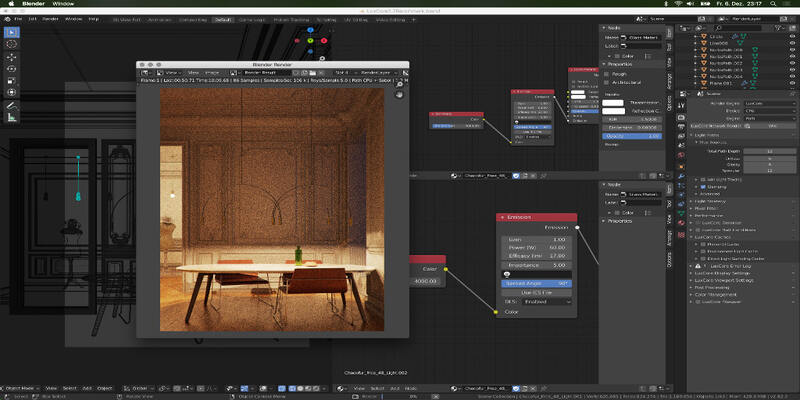
Pros
Popular and free.
Powerful, easy to use and packed with useful features.
Has a range of material types.
Cons
Can be a bit intimidating for a first-time user.
LuxCoreRender is another popular free 3D rendering software that’s powerful, easy to use and packed with useful features
This software offers physically based rendering, meaning that it’s built on physically based equations that model the transportation of light. This means the software fully supports high-dynamic range rendering and allows it to accurately capture a wide range of phenomena, such as subsurface scattering and volumetrics, producing photorealistic results.
LuxCoreRender has a range of material types, from generic materials like matte and glossy to physically accurate representations of glass, metal and car paint. You can mix and modify all materials using textures. All materials also support bump and normal mapping.
Some of the advanced features offered by LuxCoreRender include tone mapping and motion blur, depth of field and lens effects. It uses OpenCL to run on any number of CPUs and/or GPUs available, making for reduced rendering times due to the favorable performance of GPUs over CPU-only rendering.
Another benefit of this software is that it supports dynamic and interactive scene editing, allowing you to pause and continue at any time. It even allows for the current state of renderings to be written to files so that you can continue rendering at a later date, either on the same computer or a different one.
This software supports both unbiased rendering and biased rendering to help streamline the process. You can also use instanced objects in this 3D rendering software.
Best Paid 3D Rendering Software
Iray – Quality GPU Ray Tracing Renderer
- Price: From $295 per year
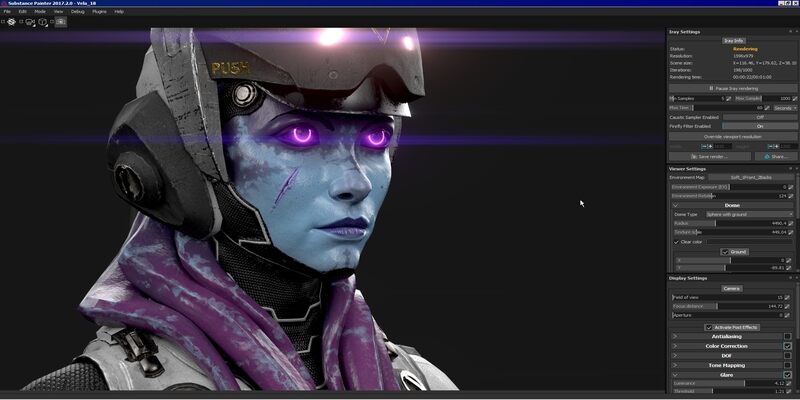
Pros
Beginner-friendly.
Great for many industries.
Uses AI denoising to generate photorealistic imagery with great speed and efficiency.
Cons
No major drawbacks.
Developed by NVidia, Iray is a biased GPU renderer that’s one of the best 3D CAD rendering software aimed at beginners, students and hobbyists who don’t have expert rendering knowledge, as well as professionals.
However, while it may be beginner-friendly, Iray’s quality shouldn’t be underestimated. This intuitive, physically based rendering technology uses AI denoising, CUDA, NVidia OptiX and Material Definition Language (MDL) to generate photorealistic imagery with great speed and efficiency, making it one of the most realistic 3D rendering software.
To explain that in more detail, AI denoising is the use of Tenor Cores on the latest NVidia hardware to bring the power of deep learning to both final-frame and interactive photorealistic renderings. This speeds up the completion of final images and smoothes interactive rendering, producing a faster understanding of your scene’s composition and lighting.
NVidia MDL defines the property of material, from surface colors to the light emission of surfaces. This also includes surface geometric properties that aren’t usually modeled in the geometric description of surfaces, including displacements, bump maps and cut-outs.
Despite being a GPU renderer that’s developed for real-time usage scenarios, Iray also has many of the features typical of CPU solutions, including caustics, volumetrics, instancing and subsurface scattering.
Iray is targeted at the architecture, engineering, construction, education, manufacturing and entertainment industries. It has been used in the design of several automotives and is one of the best 3D car rendering software, with the NVidia website covering some of the projects it has been involved in.
Arnold – Fast CPU Ray Trading Render Software
- Price: $45 per month or $360 per year
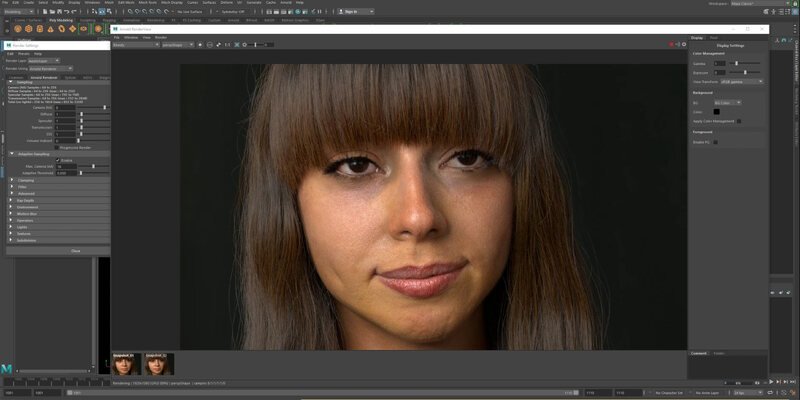
Pros
High-quality and has a number of supported plugins for a number of top 3D modeling software.
Capable of real-time rendering.
Its material editor is node-based.
Cons
Rendering times can be a bit slow.
Arnold is a high quality rendering software that’s developed by Solid Angle, a subsidiary of Autodesk. It has supported plugins for a number of top 3D modeling software, including Maya, 3DS Max, Houdini, Cinema 4D, Katana and Softimage.
This software was initially developed for the VFD studio Sony Pictures Imageworks and can be used to create just about anything you can imagine.
Arnold is based on a fast, CPU-based ray tracing render engine. This means it’s capable of real-time rendering, so that any changes you make during the process are automatically included in the calculations, speeding up the overall rendering process.
Arnold is commonly used in the movie and TV industries for its ability to efficiently compute light transport in CG scenes and support volumetrics to create stunningly realistic imagery. It has been used for CGI in Hollywood films such as Gravity, as well as in animated films like Monster House and Cloudy with a Chance of Meatballs. It was also used in the making of the popular video game The Witcher 3.
Another notable aspect of this top 3D rendering software is that its material editor is node-based. There are many presets available and more are constantly being added by the active user community, making for a more customizable and intuitive user experience. This is also a robust software capable of functioning smoothly even when using very large data sets.
V-Ray – Overall Best 3D Rendering Software
- Price: $745 annually for V-Ray Collection version

Pros
Provides state-of-the-art rendering for many industries.
User-friendly interface, relatively low price, and various purchasing options.
Cons
Some beginners will find it difficult to learn and understand.
Developed by Chaos Group, V-Ray is widely regarded as one of the best 3D rendering software on the market and provides state of the art rendering solutions for film, VFX, architecture, automotive design, fashion, interior design, and other industries.
This top 3D rendering software uses a biased engine that includes both CPU and GPU+CPU hybrid rendering options. It uses adaptive ray tracing technology and proprietary scene intelligence to create incredibly realistic imagery that is almost indistinguishable from an actual photograph. It can also accurately calculate the distribution of light and the physical properties of any material.
This exceptionally high quality means that V-Ray is widely used by professional teams and has been used in the making of many Hollywood blockbuster movies, including Deadpool, Iron Man 3 and Exodus: Gods and Kings, which gives you an idea of just how powerful this software is. It’s even been used in the design of Nike Air Max sneakers!
Fortunately, its user-friendly interface, relatively low price, and various purchasing options mean it’s accessible to beginners and hobbyists.
This 3D rendering and animation software is compatible with most major 3D creation suites, including 3DS Max, Maya, Revit, SketchUp, Cinema 4D and Houdini. You can either purchase the Collection version that is compatible with all programs, or for a smaller cost you can purchase V-Ray licenses that are only compatible with certain other 3D software.
Lumion – Best Architecture & 3D Interior Rendering Software
- Price: $1,817 for the standard version, $3,636 for Lumion Pro
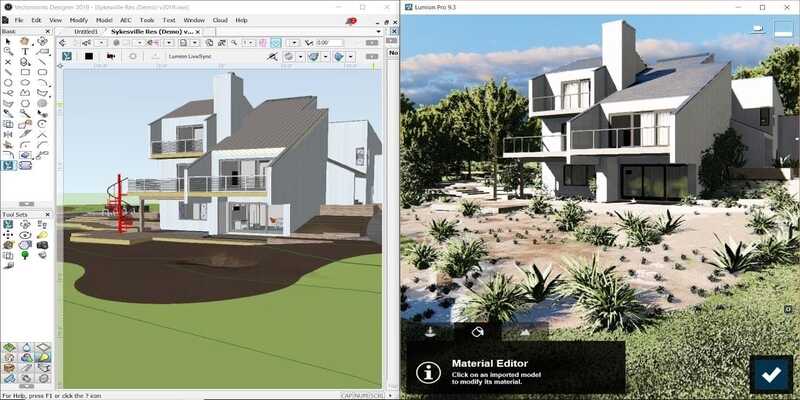
Pros
Fast, easy to use and allows your 3D designs into images, videos and 360 panoramas.
Compatible with a range of CAD software.
Offers a vast library of materials and objects.
Cons
Fairly expensive for both the standard and pro versions.
Lumion is a popular 3D rendering architectural software that’s fast, easy to use and allows you to turn 3D designs into images, videos and 360 panoramas – which you can view with VR glasses – in seconds.
This software is compatible with a range of CAD software, including popular programs like Autodesk Revit, ArchiCAD, 3DS Max, Vectorworks and Rhinoceros, so you can easily upload your architectural designs to the rendering program.
Lumion 3D rendering software offers a vast library of materials and objects, including materials, people, lighting, grass, skies, water, plants, cars and many more. You can also add a wide range of special effects. The software is capable of handling landscapes populated with thousands of these objects.
One of the best things about Lumion is its speed and ease of use. It’s one of the fastest 3D rendering software in the world, and its intuitive interface means it’s ideal for architects and designers looking to render in-house. It also renders in real-time, so you can really develop the look and feel of a project.
There are two versions of Lumion available – the standard and Pro version. Whereas the standard version offers just a third of the content library with 1.928 models and limited rendering features, Lumion Pro offers the entire content library with 5,840 models and advanced rendering features, such as advanced special effects and the ability to merge project files for team use.



